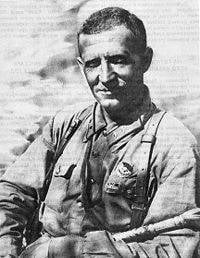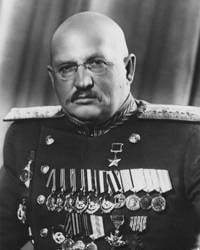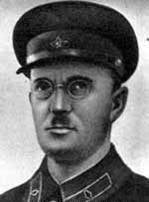Mystery of Zelim Khan
 At the end of the last century 20 in mountainous Afghanistan, under Mazar-i-Sharif, a certain Zelim Khan, the commander of one of the detachments of Amanullah Khan, who had been ousted by the rebels, became famous. According to sources, Zelim Khan was a daring and desperately courageous commander. His squad in 400 sabers appeared suddenly and inflicted very noticeable losses to government troops. Only relatively recently it became clear (until recently this information was classified) that under this exotic name was the commander of the 8 Cavalry Brigade of the Central Asian Military District of the USSR, later General of the Army and Hero of the Soviet Union Ivan Petrov, who (according to a secret agreement between I.V . Stalin and "Afghan friends") with a detachment of Red Army men acted on the side of the overthrown Khan.
At the end of the last century 20 in mountainous Afghanistan, under Mazar-i-Sharif, a certain Zelim Khan, the commander of one of the detachments of Amanullah Khan, who had been ousted by the rebels, became famous. According to sources, Zelim Khan was a daring and desperately courageous commander. His squad in 400 sabers appeared suddenly and inflicted very noticeable losses to government troops. Only relatively recently it became clear (until recently this information was classified) that under this exotic name was the commander of the 8 Cavalry Brigade of the Central Asian Military District of the USSR, later General of the Army and Hero of the Soviet Union Ivan Petrov, who (according to a secret agreement between I.V . Stalin and "Afghan friends") with a detachment of Red Army men acted on the side of the overthrown Khan.The mystery of the name - the legend
At first glance it may seem strange and, at least, incomprehensible choice of the name - the legend of the brigade commander Petrov. However, everything falls into place if we remember that it was precisely in those years that a film about the famous Chechen abrek Zelimkhan, filmed by director O. Frohlich based on the book of the same name by D. Gatuev, was shown on the screens of the Soviet country with full house In the role of the famous abrek in this film starred actor Lado Bestaev, famous for those times. This is an outstanding and one of the first actors of the Soviet silent film.
A bright actor, Ossetian by nationality Lado Bestayev himself was from Tskhinval (South Ossetia. When he was a student in Tiflis, the French film band came there, who shot the film “Fire worshipers”. They also invited Lado to one of the roles. From this film and his cinematographic biography began. At the end of 20, Bestaev starred in the adventure film Zelimkhan ”(“ Vostok-Kino ”).
This film was held in all countries throughout Europe, they wrote a lot about it. Bestaev himself was compared with actor Douglas Fernbeks. And they even wrote that "Douglas Fernbeks is all in training, and Bestaev is nature itself !!!" Even in the context of the wordless role, Bestaev was able to create an integral, rich image of a mountaineer, a protector of powerless people. For the image of Abrek Zelimkhan, practically alone, who had once fought with tsarism and the domination of officials, the glory of a noble and pious robber like Robin Hood was established. This is what the print editions of those years wrote about the popularity of this film.
A film about the famous Chechen abrek Zelimkhan.
“In Moscow, in Rostov and in other cities of the Union, a film about the famous Chechen abrek Zelimkhan goes with great success; in Rostov it has been going on for two months already ... every evening with a huge gathering of spectators ... there is a crowd at the theaters, and the places are taken, as they say, from a fight. ”
(Revolution and Highlander: 1929, No. 10, 36, see also No. 9, 76 – 78).
From the foregoing, the motives of choice are already drawn, and it becomes quite clear for what reasons and why the brigade commander chose this image. It was the Chechen abrek Zelimkhan and his legendary image that predetermined the name of the "Afghan field commander"
Below is a brief biographical note about General Petrov, a link to a biographical sketch of this outstanding man in the Great Soviet Encyclopedia and one of the publications about events in Afghanistan at the end of the 20 of the past century, in which Zelim Khan is also mentioned (I, E, Petrov). Naturally, the Afghan events are not mentioned in either the brief biography or the TSB.
Petrov I.Y.
(Great Soviet Encyclopedia)
 Petrov Ivan Efimovich - (18 (30) .9.1896, Trubchevsk, now the Bryansk Region, - 7.4.1958, Moscow), Soviet military leader, Army General (1944), Hero of the Soviet Union (29.5.1945). Member of the CPSU with 1918.
Petrov Ivan Efimovich - (18 (30) .9.1896, Trubchevsk, now the Bryansk Region, - 7.4.1958, Moscow), Soviet military leader, Army General (1944), Hero of the Soviet Union (29.5.1945). Member of the CPSU with 1918. In the Red Army with 1918. Member of the Civil War 1918 — 20. He graduated from the advanced training courses (1926 and 1931). In 1929, 1931 — 32 participated in the fight against the Basmachis (commanded by the Caucasian regiment and rifle division). With 1933, the head of the United Central Asian Military School (later Tashkent Military Infantry School). In 1940 he commanded the rifle division, from March 1941 a mechanized corps.
During the Great Patriotic War 1941 — 45: commander of the rifle division on the southern front (July - October 1941), commander of the Maritime Army (October 1941 - July 1942 and November 1943 - February 1944), 44-th army (August - OctoberNNXX - February 1942), 1942-th army (August - OctoberNNXX - February 1943), 1943-th army (August - OctoberNNXX - February 33), 1944-th army (August - OctoberNNX-Feb. 2) Black Sea Group of Forces of the Transcaucasian Front (October 1944 - March 4), North Caucasian Front (May - November 1944), 1945 of the Western Front Army (March - April 1), 1945 of the Belarusian Front (April - June XNUMX), XNUMX Ukrainian Front (August XNUMX - March XNUMX) and Chief of Staff of the XNUMX Ukrainian Front (April - June XNUMX). One of the leaders of the defense of Odessa and Sevastopol, participated in the battle for the Caucasus, in the liberation of Belarus, Czechoslovakia, in the Berlin and Prague operations.
After the war since July 1945, commander of the Turkestan Military District, since July 1952 1, the deputy chief inspector of the Soviet Army. Since April, 1953 has been the Head of the Main Directorate of Combat and Physical Training, since March 1955 1 is the Deputy Commander-in-Chief of the Ground Forces, since January 1956 is the Chief Inspector of the USSR Ministry of Defense, since June 1957 has been the Chief Scientific Advisor under the Deputy Minister of Defense of the USSR. Deputy of the Supreme Soviet of the USSR 2-th, 3-th and 4-th convocations. 5 was awarded the Order of Lenin, the 4 Order of the Red Banner, the Suvorov Orders of the 1 degree, the Kutuzov 1 degree, the Red Banner of Labor, the Red Star, the Orders of the Red Banner of the Turkmen SSR and the Uzbek SSR, medals, as well as several foreign orders.
The first invasion of Afghan ...
(Vladimir Verzhbovsky. “Soldiers of the Fatherland”, No. 11 (14))
 74 a year ago 15 April 1929, the Soviet troops, however, dressed in Afghan uniform crossed the Afghan border. It happened in almost the same place as half a century later - in the area of Tajik Termez. A group of two thousand "Afghan" horsemen had 4 mountain guns, 12 heavy machine guns and the same number of light machine guns. At the head of the troops stood Vitaly Markovich Primakov (Soviet military attache in Afghanistan from 1927 year). Although everyone called him "Turkish officer Ragib Bey." The headquarters was headed by an Afghan officer Ghulam Haydar.
74 a year ago 15 April 1929, the Soviet troops, however, dressed in Afghan uniform crossed the Afghan border. It happened in almost the same place as half a century later - in the area of Tajik Termez. A group of two thousand "Afghan" horsemen had 4 mountain guns, 12 heavy machine guns and the same number of light machine guns. At the head of the troops stood Vitaly Markovich Primakov (Soviet military attache in Afghanistan from 1927 year). Although everyone called him "Turkish officer Ragib Bey." The headquarters was headed by an Afghan officer Ghulam Haydar. The prehistory of the invasion is as follows. A month before the events, the Ambassador of Afghanistan to the USSR, General Ghulam Nabi-Khan Charkhi, and Foreign Minister Ghulam Sidiq Khan met with the Secretary-General of the Central Committee of the CPSU (B.) I. Stalin in a secret atmosphere. Afghan "comrades" asked the USSR for military assistance for Amanullah Khan, overthrown by the rebels. In fairness it should be noted that in accordance with the contract of 1921, this possibility was. Therefore, in Tashkent, on an emergency basis, formed a special detachment of carefully selected people.
The first clash occurred on the day of the border crossing. The Soviet detachment attacked the patrol post Pat Kisar. Of the 50 soldiers defending it, only two survived. A little later, reinforcements were broken down, going to help from the neighboring post of Siyah-Gerd. 16 April Raghib Bey's troops are already at the city of Kelif. Several gun shots were enough to capture it. Untrained irregular formations of Afghans retreated in panic. The next day, Primakovites occupied Khanabad city without a fight. Mazar-i-Sharif lay ahead.
29 April began fighting for Mazar-i-Sharif. Part of the Soviet detachment managed to break into the suburbs, but met stubborn resistance. Only in the evening, using the advantage in machine guns and guns, did Primakov's soldiers capture the city. The message went to Tashkent and Moscow: "Mazar is occupied by the detachment of Vitmar" (Vitaly Markovich). However, it became clear to everyone that the idea of a world revolution did not touch anyone here. The overwhelming majority of the population was hostile towards aliens.
A day later, the garrison of neighboring Deidadi tried to repel Mazar-i-Sharif. With fanatical perseverance, despite the huge losses from artillery and machine-gun fire, the Afghans attempted attack after attack. The radio operator of the Soviet detachment was forced to request cipher help. A squadron with machine guns sent to the rescue was unable to break through to the compound, meeting with superior Afghan forces. Only 26 April red-star airplanes delivered 10 machine guns and 200 projectiles to Mazar ....
May 6 Soviet aviation began to bomb the position of the Afghans near Mazar-e-Sharif. Another detachment of 400 Red Army soldiers broke through the border. He was commanded by Zelim Khan. According to some reports, Ivan Petrov was hiding under this name, the commander of the 8th cavalry brigade of the Central Asian military district, later a general of the army, a hero of the Soviet Union. With a simultaneous blow, together with the besieged Primakovites, Soviet troops managed to drive the Afghans back and drove them into the Deidadi fortress. ...
25 May after the bombing, the Red Army invaded the city. On the streets themselves fighting continued for two more days. As a result, the Afghans retreated. But Cherepanov’s artillery was left without shells, almost all machine guns were out of order. Squad lost killed 10 and wounded 30 Red Army. And then the ousted Amanullah Khan, taking the treasury, fled to the west. The continuation of the expedition became meaningless, Stalin ordered the withdrawal of Ali Avzal Khan's detachment.
Despite this aggression with the government of Afghanistan, the USSR maintained good neighborly relations until December 1979, when the 40-I army crossed the border of a sovereign state, where it was involved in a civil and inter-ethnic war. But it is already completely different. story.
Information